The Road to Net Zero: Choosing the Green Route
At the recent HKTDC Research webinar, The Road to Net Zero: Choosing the Green Route, experts discussed how enterprises can evaluate and choose, in an environmentally responsible way, trade routes and modes that will allow them to achieve sustainable development. Louis Chan, Principal Economist (Global Research) at HKTDC Research, pointed out that the use of green logistics has already become not only a worldwide trend but also a global practice and norm. Innovative and user‑friendly green logistics solutions, in particular, can help small and medium‑sized enterprises (SMEs) meet their own green requirements as well as those of their clients throughout the entire process from order acceptance to logistics and transportation. This will, in turn, drive global supply chains towards a zero‑carbon future.
Cross-border Logistics
Nicholas Fu, Economist (Global Research) at HKTDC Research, said that the megatrend of sustainable development has seen efforts being made to infuse green concepts into goods as well as services where logistics support is one of the major issues. Explaining how pressures on sustainability are likely to increase in the post‑pandemic world, Fu said: “As the world’s economy and people’s lives return to normal, Hong Kong’s economy is gradually reviving, so much so that both the value and volume of merchandise trade are rising in tandem. Some research has predicted that global trade will grow at an annual rate of 2.9% in the next 20 years, and this will trigger demand for ocean and air freights. Alongside the rapid development of global trade over the last 20 years, trade‑related carbon emissions also shot up by 90%, not least those arising from airfreights where greenhouse gas emissions are more intensive. But since 75% of global trade is carried out by sea, the fuel used by and the carbon emissions of freighters should not be overlooked.”
Fu pointed out that, during the pandemic, there was a big increase in demand for vaccines and epidemic prevention products. Adding to the rapid development in e‑commerce, the demand for cross‑border airfreight has been growing continuously. Moreover, due to pandemic prevention considerations, cross‑border travel restrictions and quarantine arrangements were implemented in many parts of the world. Consequently, increasing numbers of enterprises have adopted the (express) air shipment mode to meet cross‑border logistics needs. Fu noted that all these developments have led to increased carbon emissions, saying: “Airbus estimates that worldwide freight tonne‑kilometres (FTK) will increase from US$215 billion in 2019 to US$430 billion in 2041, of which the share of express air cargo will grow from 17% to 25%.”
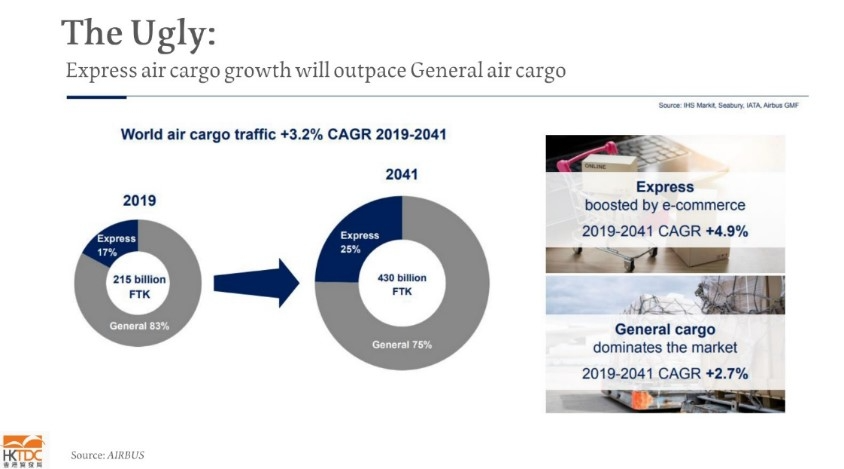
Demand for cross‑border airfreight continues its upward trend post‑pandemic.
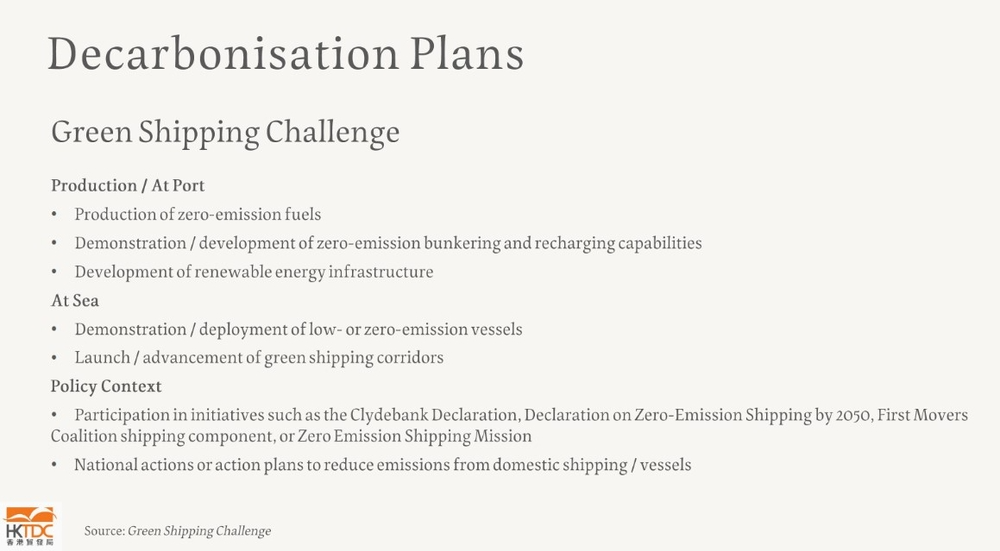
Green Shipping Challenge encourages the use of innovative technologies.
Next-generation Green Logistics
Given the amount of the greenhouse gas emissions from the aviation industry, many airfreight organisations have set up targets and action plans to reduce their carbon emissions. Detailing the action that has been taken, Fu said: “The International Maritime Organisation (IMO), the International Civil Aviation Organization (ICAO) and the International Air Transport Association (IATA) have all set up medium to long‑term plans for carbon emissions reduction and achieving net‑zero emissions for the airfreight industry. The IMO, for example, announced in 2011 a carbon reduction timetable for the next 40 years. The aim is to reduce greenhouse gas emissions by 50% and carbon emissions by 70% by 2050.”
At the 27th United Nations Climate Change Conference (COP27) last year, the US and Norway proposed a “Green Shipping Challenge” to encourage the use of innovative technologies, which could develop a new generation of green logistics to deal with carbon emissions from the production of the shipping sector and during the bunkering of ships and aircraft, as well as carbon emissions reduction policies for logistics worldwide. Looking at how well received the proposal was, Fu said: “So far, in response to the Challenge, many countries, ports and companies (notably including Amazon) the world over have pledged to join efforts to promote and develop green shipping. ICAO has also come up with a Carbon Offsetting and Reduction Scheme for International Aviation (CORSIA). CORSIA sets 2035 as a target year by which industry players are encouraged to use alternative fuels such as biofuels and the adoption of advanced aviation technologies to raise the performance and energy efficiency of aircraft to reduce the carbon footprint of the shipping industry.”
One-stop Supply-chain Financing Platform
Innovative technologies are now the main force behind the upgrading and transformation of many industries. Promoting the digitalisation of the shipping industry gives industry players an edge in managing warehouses and raising transportation capability. It can also help businesses understand customer needs and choose better and more environmentally friendly shipping routes. Taking note of the development potentials of smart logistics, FreightAmigo, a Hong Kong start‑up, offers comprehensive green logistics solutions to customers through the adoption of advanced technologies such as AI, big data, blockchain and so on. As well as providing instantaneous quotations, its platform can arrange double customs clearance, cargo insurance and trade financing for customers.
Ivy Tse, Co‑Chief Executive Officer and co‑founder of FreightAmigo, said that smart technology has become increasingly important in supply chain and purchase order (PO) management across the entire international logistics process. For businesses, the availability of transparent and real‑time logistics information can help ensure the stable supply of various factors of production and goods and prevent glitches in the production and delivery processes, thereby lowering the risks involved in global supply chains. Listing the advantages of what her company provides, Tse said: “Our one‑stop supply chain financial platform provides comprehensive trading and logistics management services including booking, tracking, automatic document management, domestic and overseas customs declaration and clearance, freight insurance and so on. This substantially reduces repetitive manual work and human errors, thus reducing labour costs.”
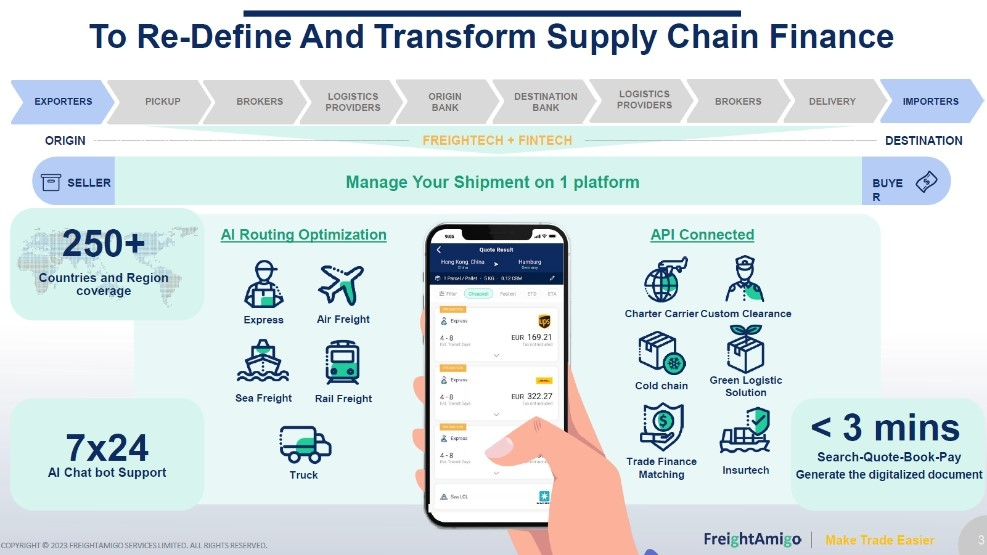
Green logistics becoming a standard component of global trade.
Carbon Footprint
FreightAmigo launched its Amigo Green package last year. Explaining that this had made it easier for customers to choose from the different green logistics options, Tse said: “For customers, this can be regarded as a green logistics planning service that costs virtually nothing. All the customer has to do is log in and make use of the big data and AI available to calculate and compare the carbon footprints, shipping time and costs of different shipping modes and routes, thereby choosing the most advantageous green logistics solution.”
Adopting green and low‑carbon practices takes time, and the logistics industry cannot achieve it in one go. Noting that, while a company is searching for a green freight mode on FreightAmigo’s platform, it can simultaneously calculate the carbon emissions for the entire shipping process, Tse said: “Our platform calculates carbon emissions for customers ‑ i.e. the quantity of carbon dioxide generated as a result of the freight activities in question. They can then buy carbon emission quotas or carbon rights accordingly to offset the carbon emissions generated. This is called carbon offset or carbon compensation. Afterwards, customers receive an electronic certificate that indicates the total offset quantity they have paid. This certificate can be produced for future sustainability audits while helping towards green branding and corporate image building.”
Tse added that, in light of the trend towards green logistics, FreightAmigo is also offering fintech solutions in addition to international logistics solutions. By linking with financial institutions in Hong Kong, mainland China and Europe, FreightAmigo has managed to improve trade tracking, thereby speeding up cash flows for the whole supply chain. Tse pointed out that this has helped provide more financing for SME users, saying: “In response to the financial sector’s environmental, social and governance (ESG) policies, many banks in Hong Kong now offer sustainable funds/loans to SMEs which are willing to adopt green logistics solutions.”
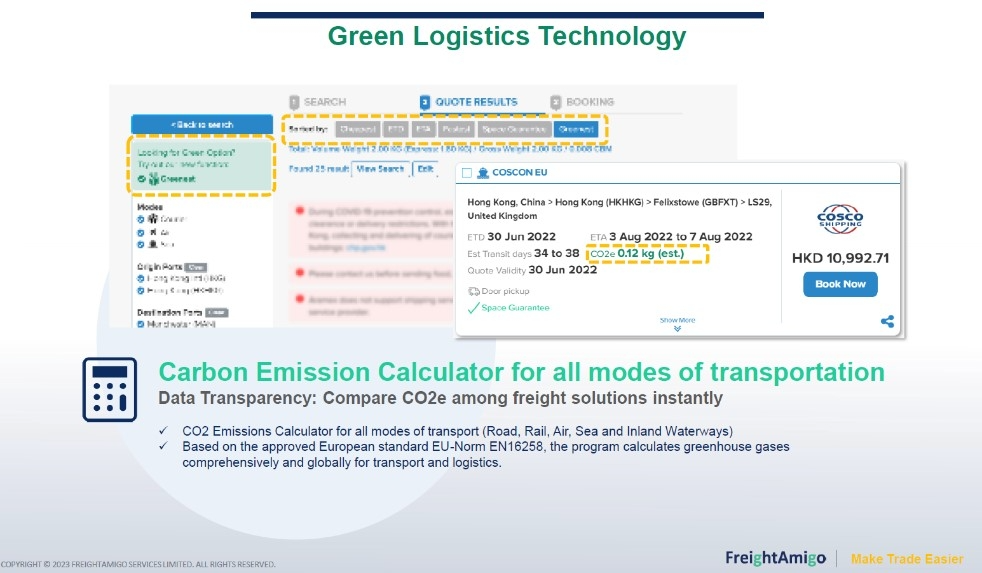
One‑stop carbon emissions calculator.























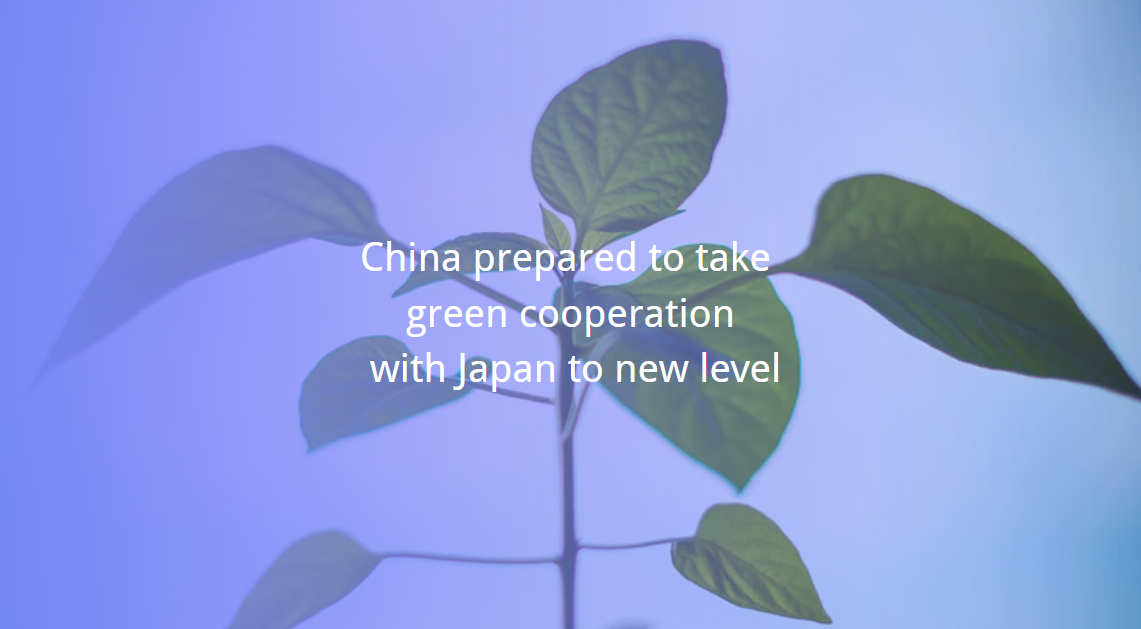
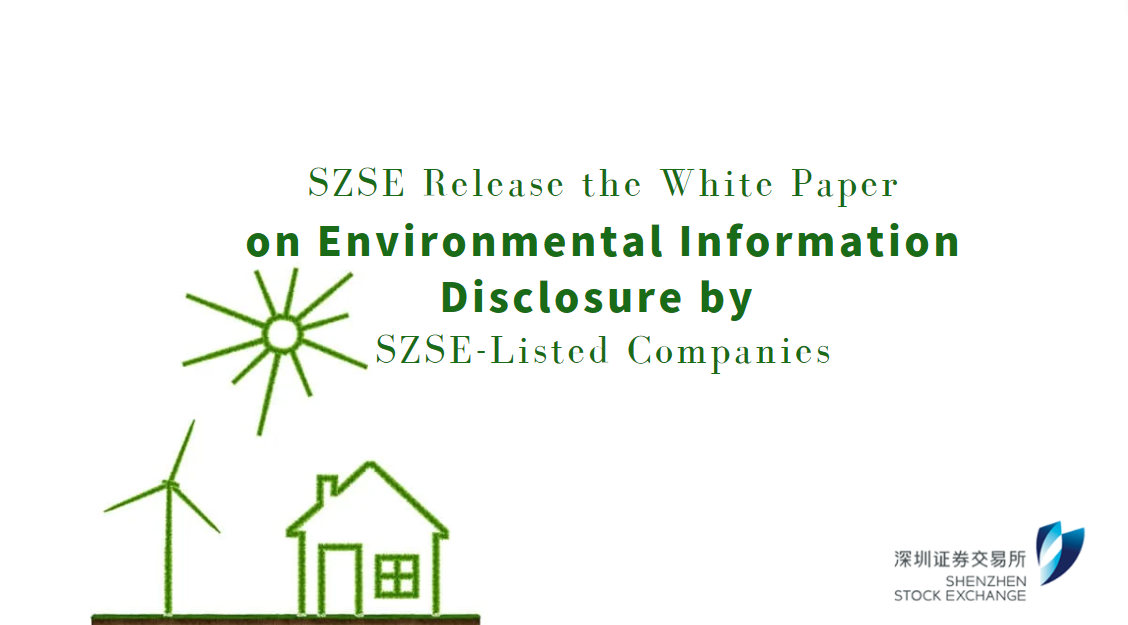
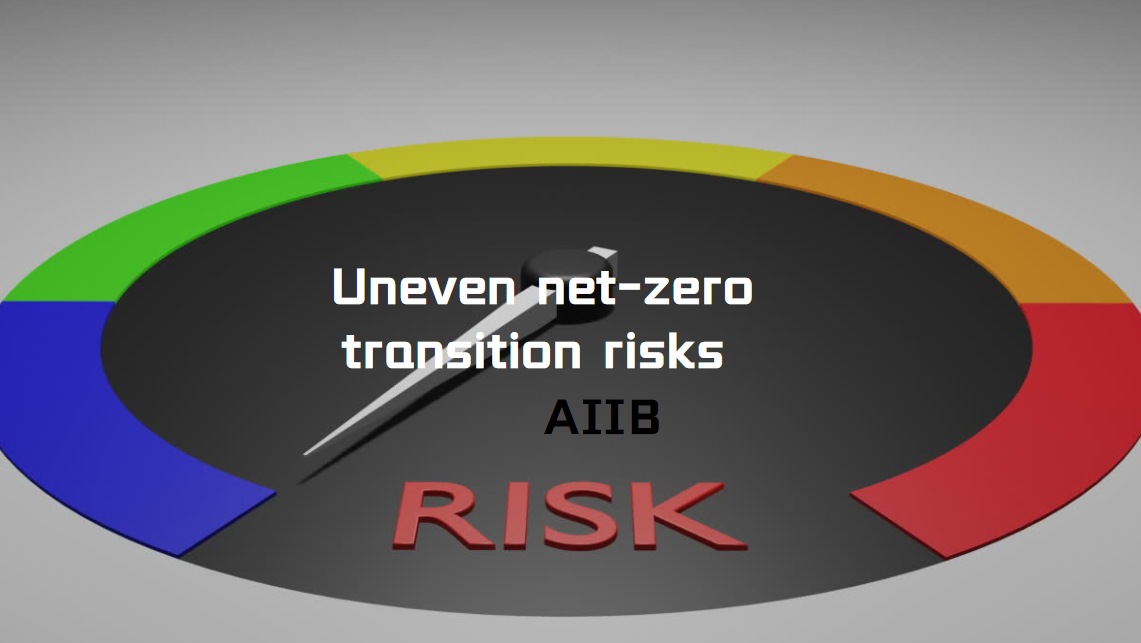



























First, please LoginComment After ~